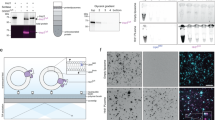Abstract
After endocytosis, some membrane proteins recycle from early endosomes to the plasma membrane whereas others are transported to late endosomes and lysosomes for degradation1. Conjugation with the small polypeptide ubiquitin is a signal for lysosomal sorting2,3. Here we show that the hepatocyte growth factor-regulated tyrosine kinase substrate, Hrs4, is involved in the endosomal sorting of ubiquitinated membrane proteins. Hrs contains a clathrin-binding domain5, and by electron microscopy we show that Hrs localizes to flat clathrin lattices on early endosomes. We demonstrate that Hrs binds directly to ubiquitin by way of a ubiquitin-interacting motif (UIM), and that ubiquitinated proteins localize specifically to Hrs- and clathrin-containing microdomains. Whereas endocytosed transferrin receptors fail to colocalize with Hrs and rapidly recycle to the cell surface, transferrin receptors that are fused to ubiquitin interact with Hrs, localize to Hrs- and clathrin-containing microdomains and are sorted to the degradative pathway. Overexpression of Hrs strongly and specifically inhibits recycling of ubiquitinated transferrin receptors by a mechanism that requires a functional UIM. We conclude that Hrs sorts ubiquitinated membrane proteins into clathrin-coated microdomains of early endosomes, thereby preventing their recycling to the cell surface.
This is a preview of subscription content, access via your institution
Access options
Subscribe to this journal
Receive 12 print issues and online access
$209.00 per year
only $17.42 per issue
Buy this article
- Purchase on Springer Link
- Instant access to full article PDF
Prices may be subject to local taxes which are calculated during checkout




Similar content being viewed by others
References
Gruenberg, J. Nature Rev. Mol. Cell Biol. 2, 721–730 (2001).
Hicke, L. Nature Rev. Mol. Cell Biol. 2, 195–201 (2001).
Dupre, S., Volland, C. & Haguenauer-Tsapis, R. Curr. Biol. 11, R932–R934 (2001).
Komada, M. & Kitamura, N. Mol. Cell Biol. 15, 6213–6221 (1995).
Raiborg, C., Bache, K. G., Mehlum, A., Stang, E. & Stenmark, H. EMBO J. 20, 5008–5021 (2001).
Stoorvogel, W., Oorschot, V. & Geuze, H. J. J. Cell Biol. 132, 21–33 (1996).
Hofmann, K. & Falquet, L. Trends Biochem. Sci. 26, 347–350 (2001).
Lloyd, T. E. et al. Cell 108, 261–269 (2002).
Stenmark, H. et al. EMBO J. 13, 1287–1296 (1994).
Hopkins, C. R. Cell 35, 321–330 (1983).
Brodsky, F. M., Chen, C. Y., Knuehl, C., Towler, M. C. & Wakeham, D. E. Annu. Rev. Cell Dev. Biol. 17, 517–568 (2001).
Hirst, J. & Robinson, M. S. Biochim. Biophys. Acta 1404, 173–193 (1998).
Levkowitz, G. et al. Mol. Cell 4, 1029–1040 (1999).
Shenoy, S. K., McDonald, P. H., Kohout, T. A. & Lefkowitz, R. J. Science 294, 1307–1313 (2001).
Rocca, A., Lamaze, C., Subtil, A. & Dautry-Varsat, A. Mol. Biol. Cell 12, 1293–1301 (2001).
Reggiori, F. & Pelham, H. R. EMBO J. 20, 5176–5186 (2001).
Urbanowski, J. L. & Piper, R. C. Traffic. 2, 622–630 (2001).
Van Kerkhof, P., Govers, R., Alves dos Santos, C. M. & Strous, G. J. J. Biol. Chem. 275, 1575–1580 (2000).
Asao, H. et al. J. Biol. Chem. 272, 32785–32791 (1997).
Takata, H., Kato, M., Denda, K. & Kitamura, N. Genes Cells 5, 57–69 (2000).
Bean, A. J. et al. J. Biol. Chem. 275, 15271–15278 (2000).
Katzmann, D. J., Babst, M. & Emr, S. D. Cell 106, 145–155 (2001).
Evan, G. I., Lewis, G. K., Ramsay, G. & Bishop, J. M. Mol. Cell Biol. 5, 3610–3616 (1985).
Mu, F. T. et al. J. Biol. Chem. 270, 13503–13511 (1995).
Gaullier, J.-M. et al. Nature 394, 432–433 (1998).
Zerial, M., Melancon, P., Schneider, C. & Garoff, H. EMBO J. 5, 1543–1550 (1986).
Vojtek, A. B., Hollenberg, S. M. & Cooper, J. A. Cell 74, 205–214 (1993).
Griffiths, G., McDowall, A., Back, R. & Dubochet, J. J. Ultrastruct. Res. 89, 65–78 (1984).
Sutter, G., Ohlmann, M. & Erfle, V. FEBS Lett. 371, 9–12 (1995).
Simonsen, A., Bremnes, B., Rønning, E., Aasland, R. & Stenmark, H. Eur. J. Cell Biol. 75, 223–231 (1998).
Acknowledgements
We thank Eva Rønning for technical assistance and Philip Woodman for helpful advice. This work was supported by the Top Research Programme, the Research Council of Norway, the Norwegian Cancer Society, the Novo-Nordisk Foundation and the Anders Jahre's Foundation for the Promotion of Science.
Author information
Authors and Affiliations
Ethics declarations
Competing interests
The authors declare no competing financial interests.
Supplementary information
Figure S1
Ubiquitination of TfR causes its sorting into the degradative endocytic pathway. (PDF 406 kb)
Rights and permissions
About this article
Cite this article
Raiborg, C., Bache, K., Gillooly, D. et al. Hrs sorts ubiquitinated proteins into clathrin-coated microdomains of early endosomes. Nat Cell Biol 4, 394–398 (2002). https://doi.org/10.1038/ncb791
Received:
Revised:
Accepted:
Published:
Issue Date:
DOI: https://doi.org/10.1038/ncb791
This article is cited by
-
Single-frame deep-learning super-resolution microscopy for intracellular dynamics imaging
Nature Communications (2023)
-
Membrane protein trafficking in the anti-tumor immune response: work of endosomal-lysosomal system
Cancer Cell International (2022)
-
The ESCRT-0 subcomplex component Hrs/Hgs is a master regulator of myogenesis via modulation of signaling and degradation pathways
BMC Biology (2021)
-
Endocytosis: a pivotal pathway for regulating metastasis
British Journal of Cancer (2021)
-
Lethal (2) giant discs (Lgd)/CC2D1 is required for the full activity of the ESCRT machinery
BMC Biology (2020)



